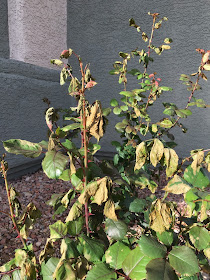Q. Our backyard is in full
sun, gets very windy, and has very poor soil. We are landscaping around a new
pool and would like a tropical look. We would love to put in a queen palm but
we read they may not do well here. Any suggestions for a different palm like
Kentia or Foxtail?
A. The queen palm won’t
work in your situation. It does not like poor soils, heat, lack of humidity and
wind. It is not a good choice for our hot desert climate in general.
 |
| Queen palm tends to look "ratty" in our desert climate and soils. |
Be
careful planting palms near a pool. Most people do not like the seeds dropping
and the mess it makes.
The
only palm which stays small and hearty for our area is the windmill palm. The
pygmy date palm is a possibility but it is sensitive to our winter temperatures
and may suffer from winter freezing. The Mediterranean fan palm stays short but
can get quite large in diameter. Both Kentia and Foxtail palms are not meant
for our climate.
 |
| Kentia palm is considered a "tropical" palm and intended for interior use in desert climates. |
There
are plenty of plants that give a tropical look to a landscape that are desert
adapted and tolerant of our soils. Mesquite, desert bird of paradise, flax,
ornamental grasses, canna lilies, rose of Sharon, crape myrtle, Gold dust plant
(shade), papyrus, nandina, mock orange, cats claw vine, can be used to mention
a few.
Tropical
looking landscapes should be densely planted and designated as a high water use
area. Use compost and wood chip surface mulches that won’t blow easily to
improve our soils and their growth.











